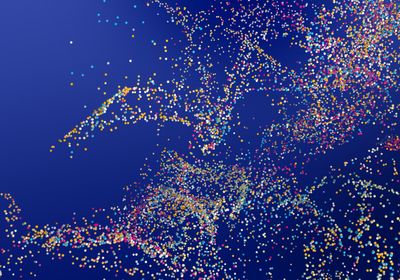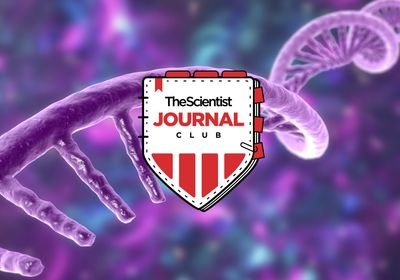ABOVE: ISTOCK.COM
Microplastics, or plastic particulates measuring less than five micrometers, are a growing environmental concern. These particulates disrupt reproduction, immune cell and microbiome composition in the gut, and neural and endocrine function in aquatic species and laboratory animals.1-4 Now, a new study published in Cell Reports suggests that the smaller the plastic, the greater the problem.5
According to Chao Wang, an immunologist at Soochow University and coauthor of the study, feeding mice nanoplastics induced a greater overall immune response in their guts than feeding mice larger microplastics. This supports previous research showing size-dependent differences in how nanoparticles interact with cells and instigate responses from them.6
Wang and his team found that nanoplastics, defined as being less than 500 nanometers in size, are more readily phagocytosed by macrophages compared to microplastics, which measure up to five micrometers. The smaller sized particulates induced a greater degree of lysosomal damage in these cells and resulted in production of the proinflammatory cytokine interleukin 1 beta (IL-1β) both in vitro and in the intestines of mice following one week of daily oral administration of the plastic. Using single-cell sequencing, Wang and his colleagues identified a population of IL-1β-producing macrophages in the intestines of nanoplastic-fed mice.
Recent studies have shown that inflammatory responses in the intestines affect the brain, so Wang and his team next assessed the gut-brain axis. After two months of daily ingestion of nanoplastics at the estimated human consumption dose, nanoplastic-exposed mice exhibited reduced cognition and short-term memory as assessed by standard neurological assessments such as the open-field test, novel object recognition assay, and the Morris water maze. These plastic-fed mice also had more activated microglia and astrocytes as well as Th17-differentiated T cells than nontreated mice.
Wang and his colleagues also observed elevated IL-1β in the brains of plastic-fed mice, but did not find IL-1β-producing cells in the brain, which suggested that these effects resulted from IL-1β-producing macrophages in the gut. “All these changes associated with brain function damage,” Wang said.
Neurological effects from the ingestion of microplastics have been abundantly documented in marine species2,7,8 as plastic pollution in water ways is an outstanding problem. “I didn’t know the enormity—how big this problem was—until I started working on it about three years ago,” said Ebenezer Nyadjro, an oceanographer at Mississippi State University and data manager at the National Centers for Environmental Information (NCEI), who was not involved with the study. “The long-term effect is if this is not controlled—if we keep dumping plastics into the water bodies, they break down into microplastics; they have an impact on those fisheries; and as studies have shown, they bioaccumulate up to higher organisms and humans—there will be impacts on us as well.”
This observation has been echoed with recent reports of microplastics in human tissues,9 underscoring the importance of Wang’s findings.
However, even after two months of daily nanoplastic ingestion, cognitive function and short-term memory impairments were mitigated by blocking IL-1β using either a monoclonal antibody or chemical inhibitor, and more promisingly, by cessation of nanoplastic exposure. One month after Wang and his team stopped feeding mice nanoplastics, they performed as well as nontreated mice in neurological assessments.
“It’s showing this effect is not permanent but can be rescued. So, it’s showing one more reason to fix the plastic pollution worldwide,” Wang said.
References
- Harusato A, Seo W, Abo H, Nakanishi Y, Nishikawa H, Itoh Y. Impact of particulate microplastics generated from polyethylene terephthalate on gut pathology and immune microenvironments. iScience. 2023;26(4):106474. doi: 10.1016/j.isci.2023.106474.
- Torres-Ruiz M, de Alba González M, Morales M, et al. Neurotoxicity and endocrine disruption caused by polystyrene nanoparticles in zebrafish embryo. Science of the Total Environment. 2023;874:162406. doi: 10.1016/j.scitotenv.2023.162406.
- Mattioda V, Benedetti V, Tessarolo C, et al. Pro-inflammatory and cytotoxic effects of polystyrene microplastics on human and murine intestinal cell lines. Biomolecules. 2023;13(1):140. doi: 10.3390/biom13010140
- Merkley SD, Moss HC, Goodfellow SM, et al. Polystyrene microplastics induce an immunometabolic active state in macrophages. Cell Biology and Toxicology. 2022;38(1):31-41. doi:10.1007/s10565-021-09616-x
- Yang Q, Dai H, Cheng Y, et al. Oral feeding of nanoplastics affects brain function of mice by inducing macrophage IL-1 signal in the intestine. Cell Reports. 2023;42(4). doi.org/10.1016/j.celrep.2023.112346
- Jiang W, Kim BYS, Rutka JT. Chan WCW. Nanoparticle-mediated cellular response is size-dependent. Nature Nanotechnology. 2008;3 https://doi.org/10.1038/nnano.2008.30
- Hamed M, Martyniuk CJ, Naguib M, Lee JS, Sayed AEH. Neurotoxic effects of different sizes of plastics (nano, micro, and macro) on juvenile common carp (Cyprinus carpio). Frontiers in Molecular Neuroscience. 2022;15:1028364. doi: 10.3389/fnmol.2022.1028364.
- Aliakbarzadeh F, Rafiee M, Khodagholi F, Khorramizadeh MR, Manouchehri H, Eslami A, et al. Adverse effects of polystyrene nanoplastic and its binary mixtures with nonylphenol on zebrafish nervous system: From oxidative stress to impaired neurotransmitter system. Environmental Pollution. 2023;317:120587. doi: 10.1016/j.envpol.2022.120587.
- Amato-Lourenço LF, Carvalho-Oliveira R, Júnior GR, dos Santos Galvão L, Ando RA, Mauad T. Presence of airborne microplastics in human lung tissue. Journal of Hazardous Materials 2021;416:126124. Doi:10.1016/j.jhaxmat.2021.126124






